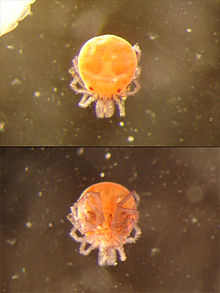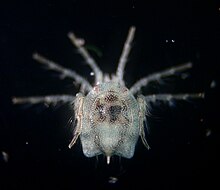Freshwater mites
| Freshwater mites | ||||||||||||
|---|---|---|---|---|---|---|---|---|---|---|---|---|

Freshwater mite in the light microscope |
||||||||||||
| Systematics | ||||||||||||
|
||||||||||||
| Scientific name | ||||||||||||
| Hydrachnidiae | ||||||||||||
| Krantz & Walter , 2009 |


The freshwater mites (Hydrachnidiae, Syn . : Hydrachnidia, Hydrachnellae, Hydracarina) are a group of parasitic gonina living in the water within the suborder prostigmata of the mites . Depending on the author, it comprises seven to eight superfamilies and is represented worldwide with several thousand species in 47 families . These mites colonize all wetlands such as still waters (temporary small bodies of water, lakes, ponds) and flowing waters (rivers, streams and springs). Some species are also found in the groundwater. Two genera with a total of 17 species are also represented in the marine area of coastal waters.
features
The systematic position of this group is controversial, many authors and especially older literature assumed a probably polyphyletic group that shows similar characteristics only through the adaptation of the way of life to the water. Today the group but is often as monophyletic classified, mainly due to the cuticle existing glands ( Glandularia ), which gives it otherwise with any other mite group. Many freshwater mites have the typical webbed hairs on their legs. The palps of the Hydrachnidia are usually five-limbed.
breathing
Freshwater mites share the same respiratory system as other arachnids . This enables them to breathe outside of the water. They have a closed tracheal system , which, however, communicates with the environment through the surface of the skin. If the skin is heavily thickened for protection, there are tight, fine pores that reach up to the ramifications of the trachea. This enables gas exchange. A correspondingly high oxygen content in the water is crucial. This makes freshwater mites an indicator of water quality . The mites swim in oxygen-rich layers close to the surface when they are under stress or the oxygen content on the ground decreases. Many species can be found on aquatic plants that release oxygen on their leaf surface. With the hind legs, which are equipped with webbed hair, they can pour in fresh water even while sitting.
Systematics
The system includes the following superfamilies and families that are widespread in Europe:
- Superfamily Arrenuroidea
- Superfamily Eylaoidea
- Superfamily Hydrachnoidea
- Superfamily Hydrovolzioidea
- Superfamily Hydryphantoidea
- Superfamily Hygrobatoidea
- Superfamily Lebertioidea
In some cases, those living in the interstitial of the rivers will also
- Superfamily Stygothrombidioidea with only one family
counted to the group of freshwater mites.
Types (selection)
- Arrenurus buccinator
- Arrenurus globator
- Atractides ovalis ( sickle foot mite )
- Frontipoda musculus ( crustacean mite )
- Hydrachna globosa ( globe mite )
- Hydrachna geographica
- Hydrodroma despiciens ( yellow-footed mite )
- Hydryphantes ruber ( saddle mite )
- Hygrobates longipalpis ( hedgehog mite )
- Eylais extendens ( eyeglass mite )
- Lebertia insigens ( hop mite )
- Lebertia lineata ( rune mite )
- Limnesia spec. ( Pond mites )
- Limnochares aquatica ( bag mite )
- Neumania vernalis ( glass mite )
- Panisus michaeli ( spot mite )
- Piona nodata
- Sperchon glandulosus ( source mite )
- Unionicola aculeata
Individual evidence
- ↑ a b Reinhard Gerecke: Freshwater mites (Hydrachnellae) . Lauterbornia, H. 18, pp. 1-84, 1994
- ↑ Gerald W. Krantz, David E. Walter (Eds.): A Manual of Acarology. 3rd edition. Texas Tech University Press, Lubbock TX 2009, ISBN 978-0-89672-620-8 , pp. 256-272.
literature
- Ilse Bartsch, Cornelis Davids, Ralf Deichsel, Antonio Di Sabatino, Grzegorz Gabrys, Reinhard Gerecke, Terence Gledhill, Peter Jäger, Joanna Makol, Harry Smit, Henk van der Hammen, Gerd Weigmann, Andreas Wohltmann, Eberhard Wurst: Chelicerata: Acari I ( = Freshwater fauna of Central Europe. 7 / 2-1). Spectrum Academic Publishing House, Heidelberg 2007, ISBN 978-3-8274-1693-3 .
- Antonio Di Sabatino, Reinhard Gerecke, Terence Gledhill, Harry Smit: Chelicerata: Acari II (= freshwater fauna of Central Europe. 7 / 2-2). Spektrum Akademischer Verlag, Heidelberg 2010, ISBN 978-3-8274-1894-4 .
- Reinhard Gerecke: Freshwater mites (Hydrachnellae). An identification key for the genera of the Hydrachnellae known from the Western Palearctic with an introductory overview of the mites that occur in the water. In: Lauterbornia. H. 18, 1994, ISSN 0935-333X , pp. 1-84.


